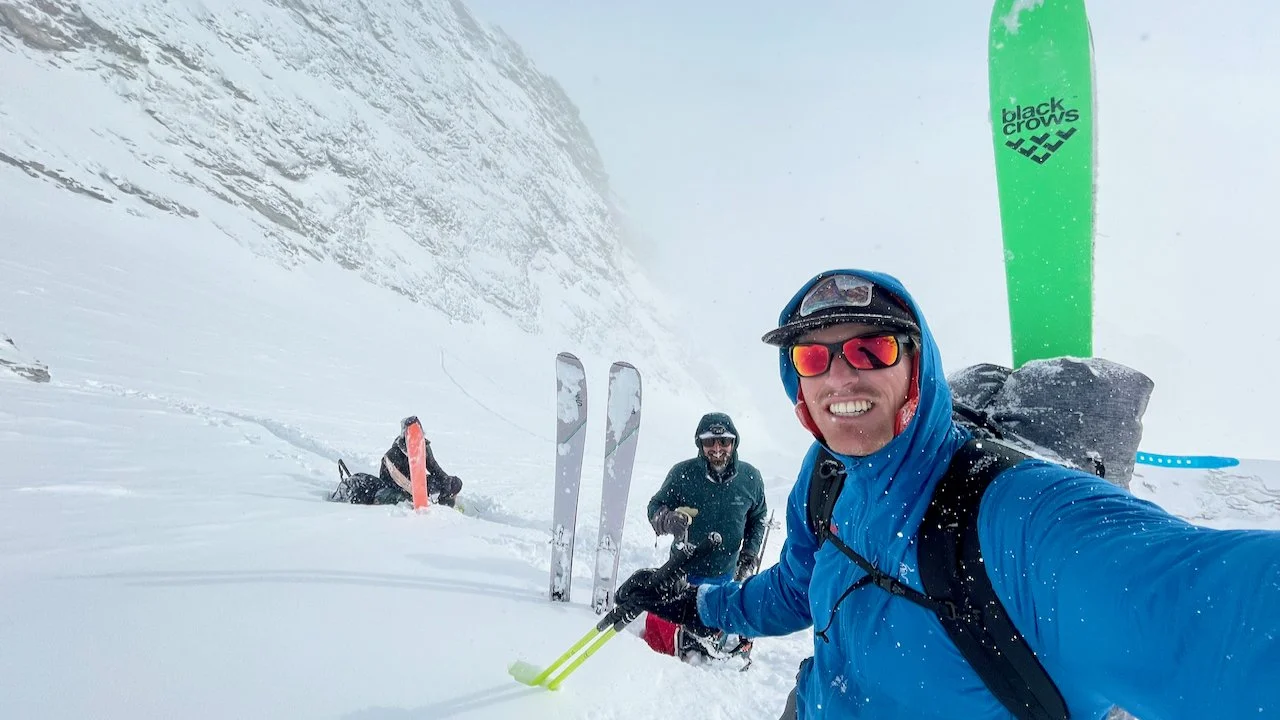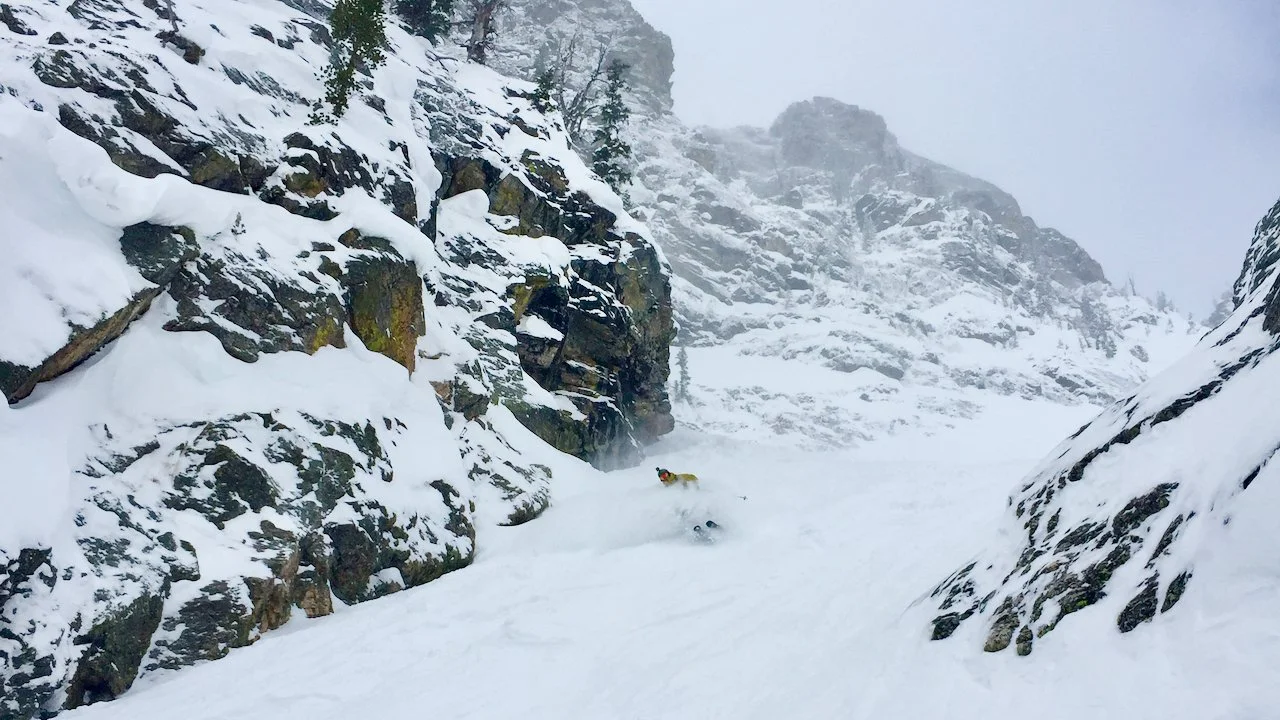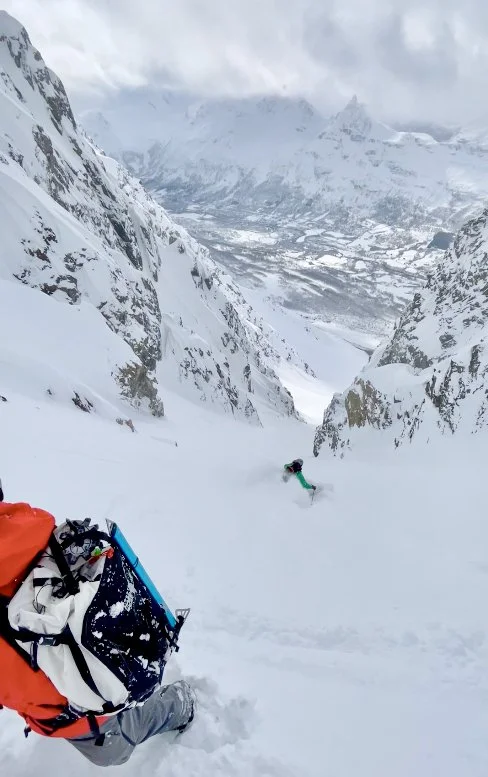
Stepping Out: Decision-making for Advanced Backcountry Skiers
Course Length: 3 days minimum, custom dates
Maximum Group Size: 4 skiers, 1 guide
Location: Tetons, Lake Tahoe, Salt Lake City, Telluride, Boulder, Vail, Canada, or the Alps.
Skiing Ability: Advanced
Uphill Ability: 3,000 vertical feet per day minimum
Price: Standard rates apply
Waist deep in the Skillet Couloir, Tetons
I meet a lot of experienced backcountry skiers who want to ski bigger lines in better snow with more certainty. They often know how to assess avalanche hazard, how to make a tour plan, and how to dig a snowpit, but they lack the confidence to step out into bigger terrain when they don’t see anyone else doing it first. They also don’t have the training to perform ski cuts to manage surface instabilities. Fortunately, professional ski guides have a system for quickly assessing avalanche hazard with fast, focused observations to make important decisions about where to ski and where the best snow will be found. They also use ski cuts as a risk management tool to cautiously open terrain.
This course is designed for backcountry skiers and split-boarders who seek more tools and mentorship than a level 1 or level 2 avalanche course can provide. In small and efficient groups, we’ll move through the mountains and ski terrain with an eye towards snowpack analysis and data-driven decision-making. Whereas traditional avalanche courses focus on identifying terrain to avoid, we will identify and ski terrain with the best snow and the most manageable avalanche hazard. We will learn and practice techniques to gather snowpack data in order to choose specific terrain for “stepping out” as we gain more confidence in the snowpack.
Over three days, you’ll learn and practice the techniques that you should be employing in your own backcountry skiing and ski mountaineering. Afterwards, you’ll have the confidence to lean on your observations to create your own slope-specific avalanche forecasts. You’ll also walk away with experience cautiously opening new terrain. You’ll be able to show up anywhere in the world and know exactly which observations you need in order to start feeling confident in your terrain choices. And, you’ll have experience using the advanced group decision-making techniques that the pros use.
Deep powder in the Apocalypse Couloir, Tetons. Skier: Jeff Colt
Curriculum components:
Online Resources: In 2024, there are so many online resources with avalanche, snowpack, and weather data that you should never feel like you are in the dark about tour planning. I will present all of the useful websites, databases, and tools that I use to plan and execute trips around the world. I spend a lot of time showing up in new destinations in the middle of winter, and I have to nail it on day 1. I’ll show you how I do that. We’ll also talk about modern phone apps to help you execute your plan like a pro.
Gear Selection: If you think all backcountry skiing gear is created equal, think again. I’ll go through exactly what I bring in my pack for different regions, weather patterns, and snowpacks. The tools I bring to gather information change from day to day. We’ll discuss the modern, lightweight gear you need to travel in the backcountry, and that which you don’t.
Initial Impressions: Data-gathering begins well before you get to the trailhead. I start gathering information with my senses as soon as I step off the airplane or drive into a new mountain range. Recreational avalanche courses teach you to look for avalanches, which is important. We’ll go much deeper into the information that you can gather before you even touch the snow.
Moving Tests: If you’re standing still, you’re not skiing. How often do you allow time in your tour plan for stopping and taking observations? Probably never. It’s important to learn how to gain information about the snowpack as you move through the mountains. Many standardized avalanche courses touch on this, but advanced backcountry skiers need to be experts at taking fast observations. The more targeted observations you can make on a tour, the larger your dataset when you have to make an important decision. The tests you perform and the information you gather on the move should be targeted towards what kind of avalanche problem are you anticipating?
The 15-Minute Snowpit: Snowpits can be an invaluable asset to backcountry skiers and avalanche forecasters, but in a world where time and energy are limited, we don’t want to dig too many of them. Knowing when to dig, how to dig efficiently, and what specifically to look for in snow profiles is an important skill for advanced backcountry skiers.
Strategic Mindset: Human factors contribute to 93% of avalanche accidents. If you’ve ever gone skiing with a big group, you know why. Our individual, subjective judgments are often at odds with objective, rational analysis. When we add in group dynamics, important decisions are often made poorly. But what if we could use our subjective biases to help augment our rational analysis, making human factors work to our benefit? A group strategic mindset helps you do this, and it’s a powerful modern tool for backcountry skiers. We will use this technique on every day of the course.
Ski Cutting: While this technique covers everything from jumping on test slopes to flushing loose snow down steep couloirs, most backcountry skiers fear this perceived “dark art.” In reality, triggering small avalanches is one of the most informative tools to advanced backcountry skiers. Rather than bee-lining it straight to our objective and ski cutting, we’ll use ski cuts to confirm or deny our hypothesis about surface instabilities. We’ll discuss why we ski cut, the conditions in which ski cutting is indicated, and practice how to do it properly and safely. We’ll also practice how to use the rope to add a margin of safety to the technique.
Finding the Best Snow: A lot of skiers know how to avoid avalanches, but not many skiers know how to consistently find good snow. In addition to identifying safe terrain, we’ll also focus on finding the best snow conditions. This is the whole point of backcountry skiing, but it’s harder than it sounds. We’ll discuss different techniques for making sure each run you take is a rad one.
Rescue (optional): Let’s face it… you and your backcountry skiing crew probably don’t practice avalanche rescue as much as you should. Maybe you always talk about practicing more, but you never get around to it. It’s ok, we’re all busy, and we don’t want to spend our precious time off doing rescue practice instead of skiing. This optional day will be used entirely for rescue practice in real mountains, not some meadow near the parking lot. We’ll cover correct rescue technique, emergency communication, complex scenarios, and group management during rescues.
Technical rope skills for skiers (optional): Whether you are taking a belay for a ski cut, approaching a cornice from behind, rappelling over a short cliff, or roping up for glacier travel, skiers should know how to use ropes to add security. Many skiers think that rope skills are only for climbers, and I guarantee that these skiers are missing out on a lot of ski terrain. When you feel comfortable packing a short length of skinny rope and you know that it’s not dead weight in your pack, you’ll be amazed at how much new terrain you’ll be able to explore. We’ll spend an entire day covering anchor-building for skiers, alpine belays, rappelling, and whatever else your crew wants to learn and practice.
Opening the East Face of Teewinot, Tetons. Photo Credit: Adam Wirth
DAILY SCHEDULE:
Pre-course: You’ll take in a lot of information before the course begins, including some online learning components so that we can hit the ground running on day 1. You’ll familiarize yourself with the online resources that the pros use, read the scientific papers that have shaped how professionals manage avalanche hazard, and make some hypotheses about the avalanche conditions and snow quality where we’ll be travelling. You’ll also pick an inspiring line for a potential objective for day 3.
Day 1: Assessment. We’ll start with a brief morning meeting so that the group is on the same page. Then, we’ll travel through the mountains and start gathering data. On this day, we’ll focus on all of the ways professionals take observations, from initial impressions to movings observations to snowpits. We’ll identify the correct terrain for gathering information about a bigger potential objective for day 3. Not only will we gather important data, but we’ll repeat the observation process to practice each technique and to grow our dataset.
Day 2: Stepping Out. Another morning meeting will be followed by a bigger tour. Today, we’ll use what we learned yesterday to try to push into bigger terrain, if conditions allow. We’ll bite off small chunks of manageable terrain and practice ski cutting along the way, hopefully implementing this technique in small pieces of avalanche terrain. If conditions don’t allow safe travel on steep slopes, we’ll still have the opportunity to practice ski cutting in benign terrain. Again, we’ll seek information that builds confidence for our larger objective.
Day 3: Skiing a Big Line. Another morning meeting, then we’ll head out to ski a significant objective. It might be the same one that you identified before the course, or it might be modified based on our observations of conditions. You’ll put your new skills to use, including finding the best snow, confirming that your terrain decision is reasonable, and using ski cutting to manage any further risk.
Days 4-5 (optional): These days can be used for additional practice with the techniques covered in the first three days. We can also use this day for rescue practice or learning technical rope skills for skiing. If you want an additional rescue practice day, we might do that on Day 1, depending on weather and conditions.
Hunter Bryant opens the Lakselv Couloir, Lyngen Alps, Norway





